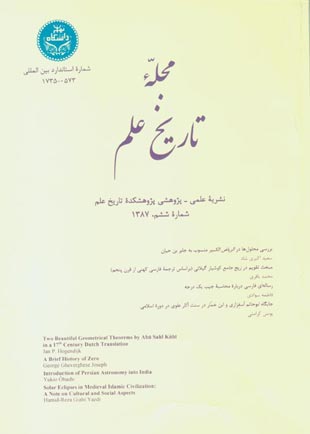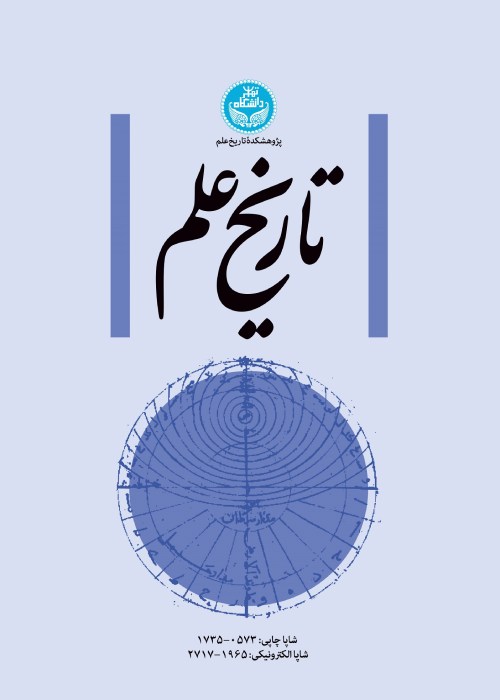فهرست مطالب

مجله تاریخ علم
سال ششم شماره 1 (پیاپی 6، بهار و تابستان 1387)
- 204 صفحه،
- تاریخ انتشار: 1387/03/23
- تعداد عناوین: 12
-
-
صفحه 1سهم دانشمندان ایرانی در میراث علمی تمدن اسلامی نیازی به یادآوری ندارد و گنجینه گرانبهای نسخه های خطی و اسناد بر جای مانده از دوران شکوفایی علم در این تمدن بهترین گواه آن است؛ ولی کاری که برای شناساندن و احیای این گنجینه تاکنون در ایران صورت گرفته به هیچ وجه مایه سربلندی نمی تواند باشد.
امروز با وجود ابزارهای ارتباطی گوناگون (زیراکس، میکروفیلم، لوح فشرده، دورنگار، پست الکترونیکی، رایانه،...) که دسترسی به منابع را بسیار آسان تر کرده است، جای آن است که دانشوران ایرانی با پژوهش علمی در این نسخه های خطی، حق شناسی خود را نسبت به گذشتگان ابراز کنند. به ویژه در حال حاضر که مراکز پژوهش در تاریخ علوم دوره اسلامی در غرب یکی پس از دیگری تعطیل می شود و می کوشند تا سهم میراث غرب را در تمدن جهان پررنگ تر بنمایند.
-
صفحه 3الریاض الکبیر منسوب به جابر بن حیان، بنا به مقدمه مؤلف یکی از آثار مهم برای ورود به صناعت کیمیا است. باب ششم این اثر به معرفی محلول های اسیدی و بازی مختلف، شیوه تولید و اثرات آن ها اختصاص دارد.
در این مقاله روش جابر در ساخت محلول ها از باب ششم الریاض الکبیر، ترجمه، و در حد امکان بررسی و تحلیل، و فرمول ها، خواص مواد واکنش دهنده و محصولات آزمایش های جابر بیان می شود.
کلیدواژگان: کیمیا، جابر بن حیان، الریاض الکبیر، محلول -
صفحه 21نخستین فصل از مقاله اول زیج جامع، رساله نجومی مهم کوشیار گیلانی، اخترشناس ایرانی که حدود 10 قرن پیش می زیست، به مبحث تقویم اختصاص دارد. در این فصل کوشیار انواع تقویم های شناخته شده در زمان خود، ویژگی های آن ها و چگونگی تبدیل آن ها به یکدیگر را بیان می کند. ویرایشی از یک ترجمه فارسی کهن این فصل، همراه با مقدمه و توضیحات در این مقاله آورده می شود.
کلیدواژگان: کوشیار گیلانی، زیج جامع، تقویم، تاریخ -
صفحه 69در بیان استخراج جیب یک درجه رساله ای است به زبان فارسی از مصنفی ناشناس که ظاهرا به منظور تقریر و توضیح روش محاسبه جیب (سینوس) یک درجه بر اساس شرح قوشچی (د. 879 ق) بر زیج الغ بیگ (فارسی) و رساله فی استخراج جیب درجه واحده (عربی) اثر قاضی زاده (د. حدود 840 ق) تالیف شده است. اثری که مبدع اصلی این روش، غیاث الدین جمشید کاشانی (د. 832 ق)، در این باره نوشته، تاکنون به دست نیامده، اما اثر قاضی زاده که در واقع تحریری است از روش کاشانی، در نسخه هایی متعدد برجای مانده است. قوشچی نیز بدون ذکر نام کاشانی، روش وی را شرح می دهد.
کلیدواژگان: جیب یک درجه، کاشانی، قاضی زاده، الغ بیگ -
صفحات 105-113
رساله آثار علوی ابوحاتم اسفزاری (د. ح. 506-513 ق دربردارنده برخی از دیدگاه های ارسطو (384-322 ق.م) است که در روایت عربی آثار علوی وی دیده نمی شود؛ زیرا ابن بطریق، پدیدآورنده روایت عربی این اثر، برخی جاهای کتاب را ترجمه نکرده و در ترجمه برخی جاهای دیگر نیز خطاهایی شگرف مرتکب شده است. اسفزاری همچنین به نکاتی اشاره می کند که در هیچ یک از دو روایت یونانی و عربی نیامده است. از این رو به نظر می رسد وی افزون بر بهره گیری از این ترجمه مخدوش، به منابع دیگری که به نحوی با روایت اصلی کتاب ارسطو مرتبط بوده اند، دسترسی داشته است. احتمالا یکی از این منابع، رساله الآثار المخیله فی الجو الحادثه عن البخار المائی ابن خمار (زاده 331ق) بوده است. آثاری که بعدها دانشمندان ایرانی در این باره نوشتند، به نحوی چشمگیر از آثار علوی اسفزاری تاثیر پذیرفته است.
کلیدواژگان: اسفزاری، آثار علوی، ابن خمار -
صفحه 115
-
صفحه 119
-
Page 3Al-Riyādh al-Kabīr, ascribed to JābirIbnḤayyān, according to its introduction, is one of the most important basic texts for learning alchemy. The sixth chapter of this book is devoted to introducing different acid and alkaline solutions, preparation and effects of them. On the basis of the sixth chapter of Al-Riyādh al-Kabīr, this article investigates and analyzes Jābir’s method for solution preparation, and explains chemical formulas and properties of reactants and products of his experiences.
-
Page 21The first section of Book I of al-Zij al-Jami‘ ("The Comprehensive astronomical tables") by Kushyar ibn Labban al-Jili (G?lan?), the Iranian astronomer who lived around ten centuries ago, is dedicated to the subject of calendars. In this section, Kushyar describes different types of calendars known in his time, their characteristics, and the methods for converting them to each other. Edition of an early Persian translation of this section, with introduction and commentary is provided in this article.
-
Page 69Dar Bayan-i? Istikhradj-i Djayb-i Yik Daradja is a Persian treatise by an anonymous author. The author’s purpose is to describe and explain a method for the determination of the Sine of one degree according to? ?sh ch?’s Persian commentary on Ulugh Beg’s Z?dj, and? ???z?da’s Arabic treatise entitled Ris?la fi? Istikhradj Djayb Daradja Wahida. Kad?zada’s work, extant in several manuscripts, is, in fact, a revision of the lost work of the real inventor of the method, Kashani(al-Kashi). Kush ch? in his commentary explains Kashan?’s method, without mentioning his name. In this article Dar Bayan-i? Istikhradj-i Djayb-i Yik Daradja is rewritten based on its unique manuscript, so that one can follow the traces of author’s citations from? ?sh ch? and Kad?zada’s works.
-
Pages 105-113
There are references to Aristotle’s view points about meteorology in? Asfizari’s treatise entitled Athar-i ulwi that have not been existed in the Arabic translation of Aristotle’s Meteorologica. Ibn Bitr?k, the Arabic translator, did not translate some parts of the book and there are mistakes in his translation. Asfizari has also mentioned some points which cannot be found in the original work of Aristotle; so one could say that Asfizari in addition to this Arabic translation, had access to some other sources connected to Aristotle’s originalwork. It seems that other composers of metrological works were not familiar with these sources which Al-Athar al-Mukhayyala fi al-Djaww al-Haditha an al-Bukhar al-Ma?? of Ibn Khammar is probably one of them. Later meteorological works are considerably affected by Asfizari’s Athar-i Ulwi
Keywords: Asfizari, Ibn Khammar, Islamic science, meteorology -
Page 1This article is devoted to two theorems on tangent circles, which were discovered by the Iranian geometer Abū Sahl Kūhī (4th century A.H.). The two theorems were inspired by the Book of Lemmas (maʼkhūdhāt) attributed to Archimedes. Kūhī''s original treatise is lost, but the two theorems are found in Naṣīr al-Dīn Ṭūsī''s edition of the Lemmas of Archimedes. They then appeared in Latin translations in 1659 in London and again in 1661 in Florence, and in 1695 in a revised Dutch version in Amsterdam. The present article compares the original Arabic version of Kūhī''s theorems (in the presentation of Ṭūsī) with the revised Dutch version.
-
Page 37It is generally recognised that ‘zero’ as we understand the concept today originated in two geographically separated cultures: the Maya and Indian. However, if zero merely signified a magnitude or a direction separator (i.e. separating those above the zero level from those below the zero level), the Egyptian zero, nfr, dating back at least four thousand years, amply served these purposes. If zero was merely a place-holder symbol, indicating the absence of a quantity at a specified place position, then such a zero was present in the Babylonian positional number system before the first recorded occurrence of the Indian zero. If zero was represented by just an empty space within a well-defined positional number system, such a zero was present in Chinese mathematics a few centuries before the beginning of the Common Era. The Indian culture from an early time showed interest and even fascination for large numbers and there is no contrary evidence to indicate that this was not so in the Mayan cultures. The dissemination westwards of the Indian zero as an integral part of the Indian numerals is one of the most remarkable episodes in the history of mathematics and the story is well-known.
-
Page 49The Islamic astronomy including the Persian astronomy was thoroughly introduced into India from the 14th century AD or so. Firstly, the astrolabe was introduced at the time of Fīrūz Shāh Tughluk, and a Sanskrit work entitled Yantra-rāja (1370 AD) was composed by Mahendra Sūri. At that time, some Sanskrit astronomical (or astrological) works were also translated into Persian. The astrolabe became quite popular in India, and Padmanābha wrote the second Sanskrit work on the astrolabe in 1423 AD. During the Delhi Sultanate period and the Mughal Empire period, Islamic astronomy and Hindu Classical astronomy influenced each other. I would like to discuss the introduction of the astrolabe into India and the development of astronomy in India in this period.
-
Page 83


